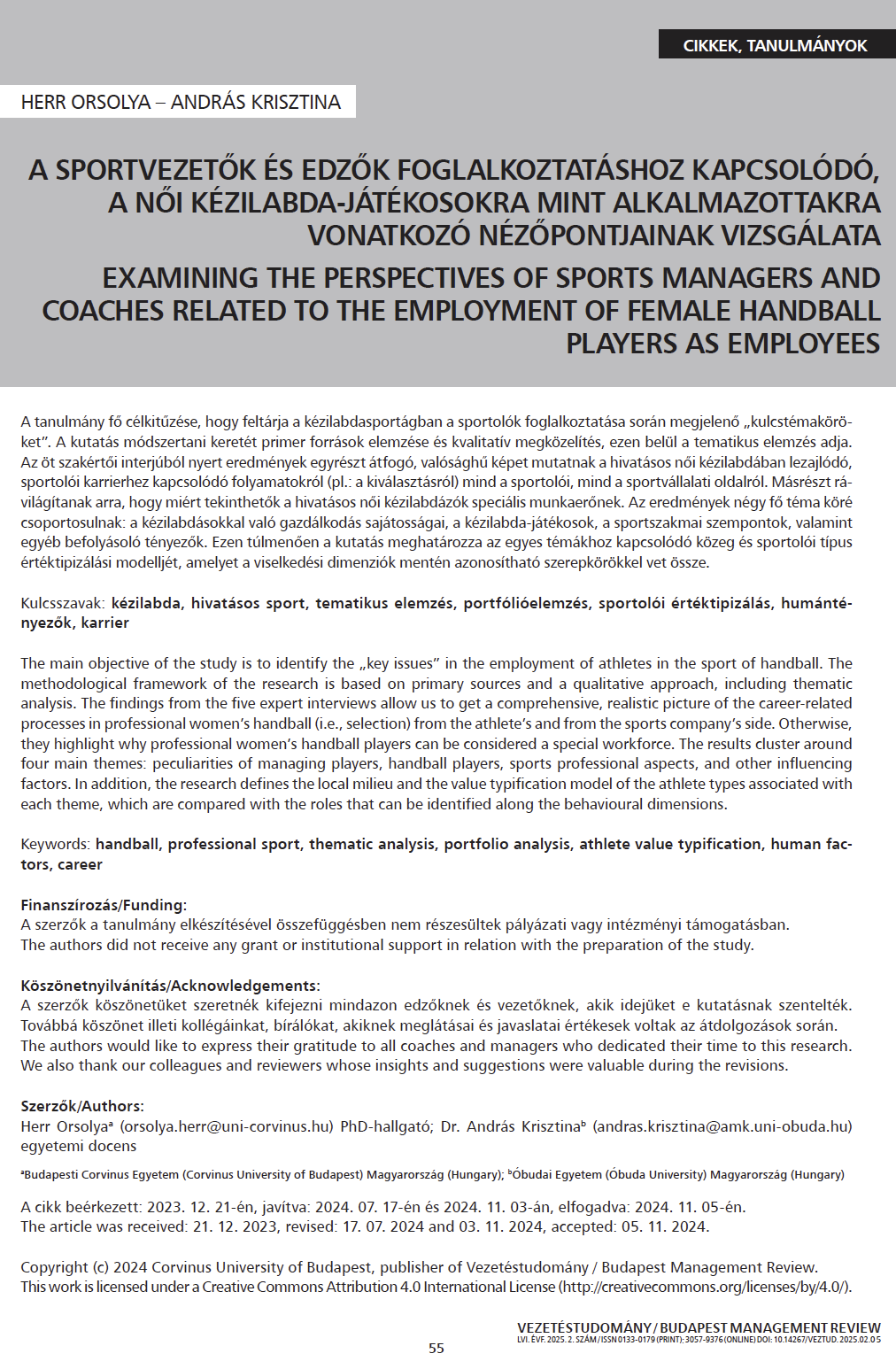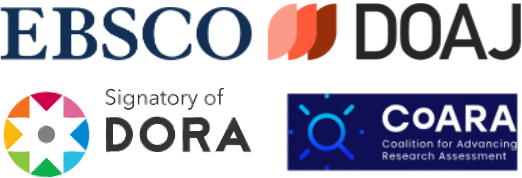Examining the perspectives of sports managers and coaches related to the employment of female handball players as employees
DOI:
https://doi.org/10.14267/VEZTUD.2025.02.05Keywords:
handball, professional sport, thematic analysis, portfolio analysis, athlete value typification, human factors, careerAbstract
The main objective of the study is to identify the „key issues” in the employment of athletes in the sport of handball. The methodological framework of the research is based on primary sources and a qualitative approach, including thematic analysis. The findings from the five expert interviews allow us to get a comprehensive, realistic picture of the career-related processes in professional women’s handball (i.e., selection) from the athlete’s and from the sports company’s side. Otherwise, they highlight why professional women’s handball players can be considered a special workforce. The results cluster around four main themes: peculiarities of managing players, handball players, sports professional aspects, and other influencing factors. In addition, the research defines the local milieu and the value typification model of the athlete types associated with each theme, which are compared with the roles that can be identified along the behavioural dimensions.
Downloads
References
Alajmi, A.S., & Arabiat, K.M. (2021). The Effect of Strategic Management on Organizational Performance: The Mediating Role of Knowledge Sharing in Private Universities in Kuwait. Journal of University of Shanghai for Science and Technology, 23(2), 65-77. http://doi.org/10.51201/Jusst12591
András, K. (2003). A sport és az üzlet kapcsolata – elméleti alapok. 34. sz. Műhelytanulmány. Budapesti Közgazdaságtudományi és Államigazgatási Egyetem. https://edok.lib.uni-corvinus.hu/61/
András, K. (2004). A hivatásos labdarúgás piacai. Vezetéstudomány, 35(klnsz), 40-57. https://unipub.lib.uni-corvinus.hu/4521/
András, K., & Havran, Z. (2015). New business strategies of football clubs. APSTRACT-Applied Studies in Agribusiness and Commerce, 9(1-2), 67-74. https://doi.org/10.19041/APSTRACT/2015/1-2/13
András, K., Havran, Z., Kajos, A., Kozma, M., Máté, T., & Szabó, Á. (2019). A sportgazdaságtani kutatások nemzetközi és hazai fejlődése. Vezetéstudomány, 50(12), 136-148. https://doi.org/10.14267/VEZTUD.2019.12.12
Babbie, E. (2001): A társadalomtudományi kutatás gyakorlata (Hatodik, átdolgozott kiadás). Balassi Kiadó.
Bakacsi, G. (2015). A szervezeti magatartás alapjai: alaptankönyv Bachelor hallgatók számára. Semmelweis Kiadó.
Bakacsi, G., Bokor, A., Császár, C., Gelei, A., Kováts, K., & Takács, S. (2006). Stratégiai emberi erőforrás menedzsment. Akadémiai Kiadó.
Bar-Eli, M., Lidor, R., Lath, F., & Schorer, J. (2023). The feudal glove of talent-selection decisions in sport– Strengthening the link between subjective and objective assessments. Asian Journal of Sport and Exercise Psychology, 4(1), 1-6. https://doi.org/10.1016/j.ajsep.2023.09.003
Barney, J. (1991). Firm resources and sustained competitive advantage. Journal of Management, 17(1), 99-120. https://doi.org/10.1177/014920639101700108
Barney, J.B. (1997). Gaining and Sustaining Competitive Advantage. Addison Wesley.
Batizi, D. (2023). A karrierút és a személyiségjegyek kapcsolata: Szisztematikus szakirodalmi áttekintés. Vezetéstudomány, 54(4), 18-27. https://doi.org/10.14267/VEZTUD.2023.04.02
Baum, J.R., Locke, E.A., & Smith, K.G. (2001). A multidimensional model of venture growth. Academy of Management Journal, 44(2), 292-303. https://doi.org/10.2307/3069456
BCG. (1970). https://www.bcg.com/publications/1970/strategy-the-product-portfolio
Blackstone, A. (2012). Principles of sociological inquiry: Qualitative and quantitative methods. Flatword. http://catalog.flatworldknowledge.com/catalog/editions/blackstone-principles-of-sociological-inquiry-qualitative-and-quantitative-methods-1-0
Boyatzis, R.E. (1998). Transforming qualitative information: Thematic analysis and code development. Sage.
Braun, V., & Clarke, V. (2006). Using thematic analysis in psychology. Qualitative Research in Psychology, 3(2), 77-101. https://doi.org/10.1191/1478088706qp063oa
Campbell, J.P., & Wiernik, B. (2015). The Modeling and Assessment of Work Performance. Annual Review of Organizational Psychology and Organizational Behavior, 2(1), 47-74. https://doi.org/10.1146/annurev-orgpsych-032414-111427
Chang, H. (2008). Autoethnography as method. Routledge.
Chikán, A. (2021). Vállalatgazdaságtan (6. átdolgozott, bővített kiadás). Akadémiai Kiadó.
Creswell, J.W., & Plano Clark, V.L. (2007). Designing and conducting mixed methods research. Sage.
Csath, M. (2023). A szellemi tőkeberuházások és vagyon szerepe a versenyképesség javításában. Hitelintézeti Szemle, 22(2), 126-144. https://doi.org/10.25201/HSZ.22.2.126
Dajnoki, K., Becsky, A., & Szabados, G.N. (2015). Sportszervezetek HR sajátosságai. Campus Kiadó.
Driskell, T., Driskell, J.E., Burke, C.S., & Salas, E. (2017). Team roles: A review and integration. Small Group Research, 48(4), 482-511. https://doi.org/10.1177/1046496417711529
Ekengren, J., Stambulova, N., Johnson, U., & Carlsson, I.M. (2020b). Exploring career experiences of Swedish professional handball players: Consolidating firsthand information into an empirical career model. International Journal of Sport and Exercise Psychology, 18(2), 156-175. https://doi.org/10.1080/1612197X.2018.1486872
Ekengren, J., Stambulova, N.B., Johnson, U., Carlsson, M., & Ryba, T.V. (2020a). Composite vignettes of Swedish male and female professional handball players’ career paths. Sport in Society, 23(4), 595-612. https://doi.org/10.1080/17430437.2019.1599201
Ericsson, K.A., Krampe, R.T., & Tesch-Römer, C. (1993). The role of deliberate practice in the acquisition of expert performance. Psychological Review, 100(3), 363- 406. https://doi.org/10.1037//0033-295X.100.3.363
Foster, G., & O’Reilly, N. (2023). Sporting club stakeholder alignment: Key stakeholder relationships and their association with on-the-field and off-the-field performance. Journal of Global Sport Management, 8(1), 183-202. https://doi.org/10.1080/24704067.2020.1805213
Freeman, R.E., & Gilbert,.R.Jr. (1987). Managing Stakeholder Relationship. In Settin, S.P., & Falbe, C. M. (Eds.), Business and Society (pp. 397-423). Lexinton Books
Frith, H., & Gleeson, K. (2004). Clothing and embodiment: Men managing body image and appearance. Psychology of Men & Masculinity, 5(1), 40-48. https://doi.org/10.1037/1524-9220.5.1.40
Grossmann, B., & Lames, M. (2013). Relative Age Effect (RAE) in football talents – the role of youth academies in transition to professional status in Germany. International Journal of Performance Analysis in Sport, 13(1), 120-134. https://doi.org/10.1080/24748668.2013.11868636
Hankinson, A., Bartlett, D., & Ducheneaut, B. (1997). The key factors in the small profiles of small‐medium enterprise owner‐managers that influence business performance: The UK (Rennes) SME survey 1995‐1997 An international research project UK survey. International Journal of Entrepreneurial Behavior & Research, 3(3), 168-175. https://doi.org/10.1108/13552559710190421
Hanton, S., Fletcher, D., & Coughlan, G. (2005). Stress in elite sport performers: A comparative study of competitive and organizational stressors. Journal of Sports Sciences, 23(10), 1129-1141. https://doi.org/10.1080/02640410500131480
Henriksen, K., Stambulova, N., & Roessler, K.K. (2010). Holistic approach to athletic talent development environments: A successful sailing milieu. Psychology of Sport and Exercise, 11(3), 212-222. https://doi.org/10.1016/j.psychsport.2009.10.005
Herr, O., & Köves, A. (2024). Achieving while looking forward: variables influencing performance in the transitory career phases of professional women’s handball. International Journal of Performance Analysis in Sport, 1-19. https://doi.org/10.1080/24748668.2024.2323372
Herron, L.A., & Robinson Jr, R.B. (1993). Entrepreneurial skills: An empirical study of the missing link connecting the entrepreneur with venture performance. National Academy of Management Meeting.
Keesing, R.M. (1974). Theories of culture. Annual Review of Anthropology, 3, 73-97. https://doi.org/10.1146/annurev.an.03.100174.000445
Koopmann, T., Faber, I., Baker, J., & Schorer, J. (2020). Assessing technical skills in talented youth athletes: a systematic review. Sports Medicine, 50, 1593-1611. https://doi.org/10.1007/s40279-020-01299-4
Kozma, M., & Kazaine, A.O. (2015). Applying the Public Sector ScoreCard in Professional Sports. In Karlovitz, J.T. (Eds.), Some Current Issues in Economics (pp. 303-316). International Research Institute sro. https://www.irisro.org/economics2015january/76Kozma-Kazai.pdf
Kroeber, A.L., & Kluckhohn, C. (1966). Culture: A critical review of concepts and definitions. Random House.
Kynsburg, Z. (1998). A sztárok mint frontemberek. Marketing & Menedzsment, 32(3), 18-19. https://journals.lib.pte.hu/index.php/mm/article/view/2047
Lath, F., Koopmann, T., Faber, I., Baker, J., & Schorer, J. (2021). Focusing on the coach’s eye; towards a working model of coach decision-making in talent selection. Psychology of Sport and Exercise, 56, 102011. https://doi.org/10.1016/j.psychsport.2021.102011
Li, P., De Bosscher, V., & Weissensteiner, J.R. (2018). The journey to elite success: a thirty-year longitudinal study of the career trajectories of top professional tennis players. International Journal of Performance Analysis in Sport, 18(6), 961-972. https://doi.org/10.1080/24748668.2018.1534197
Markowitz, H. (1952). Portfolio selection: The Journal of Finance, 7(1), 77-91. https://doi.org/10.2307/2975974
Massuça, L.M., Fragoso, I., & Teles, J. (2014). Attributes of top elite team-handball players. The Journal of Strength & Conditioning Research, 28(1), 178-186. https://doi.org/10.1519/JSC.0b013e318295d50e
Máté, T. (2022). Bevonódás és értékelés – Egy nemzetközi sportrendezvény, a Győri Európai Ifjúsági Olimpiai Fesztivál (EYOF) a lakosság szemszögéből. Vezetéstudomány, 53(6), 65-81. https://doi.org/10.14267/VEZTUD.2022.06.06
Mathieu, J.E., Tannenbaum, S.I., Donsbach, J.S., & Alliger, G.M. (2014). A review and integration of team composition models: Moving toward a dynamic and temporal framework. Journal of Management, 40(1), 130-160. https://doi.org/10.1177/0149206313503014
MKSZ. (2021). A Magyar Kézilabda Szövetség sportági stratégiája 2022-2028.
Ofoghi, B., Zeleznikow, J., MacMahon, C., & Dwyer, D. (2013). Supporting athlete selection and strategic planning in track cycling omnium: A statistical and machine learning approach. Information Sciences, 233, 200-213. https://doi.org/10.1016/j.ins.2012.12.050
Oliver, C. (1997). Sustainable competitive advantage: combining institutional and resource based views. Strategic Management Journal, 18(9), 697-713. https://www.jstor.org/stable/3088134
Penrose, E. (1959). The theory of the Growth of the Firm. Wiley.
Ramawickrama, J., Opatha, H.H.D.N.P., & PushpaKumari, M.D. (2017). A synthesis towards the construct of job performance. International Business Research, 10(10), 66-81. https://doi.org/10.5539/ibr.v10n10p66
Roberts, A.H., Greenwood, D.A., Stanley, M., Humberstone, C., Iredale, F., & Raynor, A. (2019). Coach knowledge in talent identification: A systematic review and meta-synthesis. Journal of Science and Medicine in Sport, 22(10), 1163-1172. https://doi.org/10.1016/j.jsams.2019.05.008
Roulston, K. (2001). Data analysis and ‘theorizing as ideology’. Qualitative Research, 1(3), 279-302. https://doi.org/10.1177/146879410100100302
Salleh, N.F.M., & Sukadarin, E.H. (2018). Defining human factor and ergonomic and its related issues in Malaysia Pineapple Plantations. In MATEC Web of Conferences (Vol. 150), (p. 05047). EDP Sciences. https://doi.org/10.1051/matecconf/201815005047
Sambasivan, M., Abdul, M., & Yusop, Y. (2009). Impact of personal qualities and management skills of entrepreneurs on venture performance in Malaysia: Opportunity recognition skills as a mediating factor. Technovation, 29(11), 798-805. https://doi.org/10.1016/j.technovation.2009.04.002
Schein, E.H. (2010). Organizational culture and leadership (Third edition). John Wiley & Sons.
Schmidt, M.B. (2021). Risk and uncertainty in team building: Evidence from a professional basketball market. Journal of Economic Behavior & Organization, 186, 735-753. https://doi.org/10.1016/j.jebo.2020.11.001
Sotiriadou, P., Brouwers, J., & Le, T.A. (2014). Choosing a qualitative data analysis tool: A comparison of NVivo and Leximancer. Annals of Leisure Research, 17(2), 218-234. https://doi.org/10.1080/11745398.2014.902292
Sparkes, A.C., & Smith, B. (2013). Qualitative research methods in sport, exercise and health: From process to product. Routledge.
Stambulova, N.B., & Wylleman, P. (2015). Dual career development and transitions. Psychology of Sport and Exercise, 21, 1-3. http://doi.org/10.1016/j.psychsport.2015.05.003
Szabados, G. (2003). Labdarúgóklubok stratégiái. Vezetéstudomány, 34(9), 32-43. https://unipub.lib.uni-corvinus.hu/4667/1/VT_2003n9p32.pdf
Szabó, T. (2007). Sportolók kiválasztása – Helyzetkép Magyarországon (vitaindító előadás). ELTE
Szathmári, A. (2021). „I wouldn’t do anything differently... Although I won’t let my child go in that direction”: Successful Hungarian Olympians’ understandings and experiences at the close of elite sport careers. Vezetéstudomány/ Budapest Management Review, 52(5), 68-78. https://doi.org/10.14267/VEZTUD.2021.05.06
Von Krogh, G., Ichijo, K., & Nonaka, I. (2000). Enabling knowledge creation: How to unlock the mystery of tacit knowledge and release the power of innovation. Oxford University Press. https://doi.org/10.1093/acprof:oso/9780195126167.001.0001
Woratschek, H., Horbel, C., & Popp, B. (2014). The sport value framework–a new fundamental logic for analyses in sport management. European Sport Management Quarterly, 14(1), 6-24. https://doi.org/10.1080/16184742.2013.865776

Downloads
Published
How to Cite
Issue
Section
License
Copyright (c) 2025 Corvinus University of Budapest, publisher of Vezetéstudomány / Budapest Management Review

This work is licensed under a Creative Commons Attribution 4.0 International License.
Authors assign copyright to Vezetéstudomány / Budapest Management Review. Authors are responsible for permission to reproduce copyright material from other sources.

